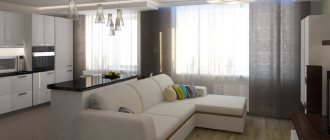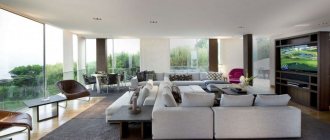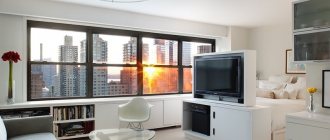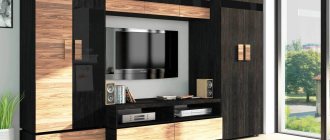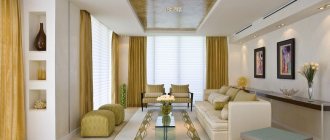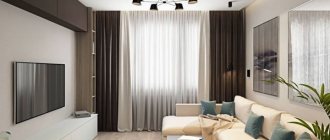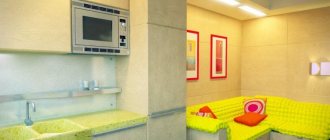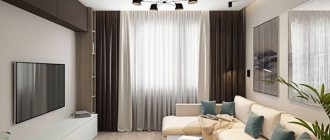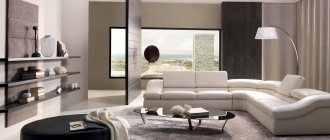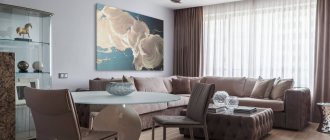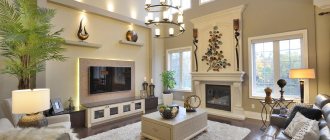Choosing the right living room lighting is easy when you know how different fixtures function and how their placement can enhance a room's decor or illuminate a focal point. You can choose from a variety of floor lamps and tabletop models to ensure your living room is properly lit and accessorized. The right lamps can set the mood, soften a rough interior, or add an accent to traditional, modern interiors.
What to consider when planning lighting in the living room?
The lighting in the largest room can be decorated using a chic chandelier. But before you think about the design, you should consider some points:
- Dark places will appear in the corners of the ceiling if there is only one chandelier or other lighting device in the center of the living room.
- There must be at least two light sources, otherwise it will be quite dark in such a spacious room.
- The chandelier can be hung above the dining table or above the place where they study correspondence or do creative work.
- To create a local lighting zone, you can use spotlights.
- The light in the living room should be soft, preferably warm rather than cold in tone.
- Spot lighting looks perfect on a multi-level ceiling in the living room.
The variety of shapes, the number of lamps and the choice of places for their installation play an important role in the design decision.
How to choose lighting fixtures
The choice of lighting fixtures is determined by the design style of the entire room. At the same time, the design and power of the luminaires must be taken into account. To ensure harmonious lighting, it is recommended to purchase floor lamps for a living room with rich tones to make the interior light and relaxed. When choosing a chandelier, you need to pay attention to the fact that the light from it is not directed directly, but is scattered throughout the apartment.
It is best to select the same light for all devices that will be installed in the same room.
Where to place the switches
It is imperative to take into account the location of the switches, that is, before performing work, they should be indicated in the project. No more than 4 switches are enough for all devices, otherwise it will not be convenient to control the light. For a large living room, it is worth using several switches for one device; this will ensure lighting control from any point.
Switch installation options:
- at the entrance;
- within the recreation area;
- next to the computer;
- by the sofa.
Most often, switches are installed near the door at a distance of 90 cm from the floor; from the door itself it should be at least 10 cm.
How to illuminate the floor
This lighting system should be placed in a separate category. It can be part of complex lighting, be local or have a decorative function. In the latter version, floor lighting is used when decorating the podium.
Downlights have several advantages:
- Doesn't irritate eyes. Especially while watching TV.
- The soft twilight pouring from under the floor relaxes and evokes an atmosphere of comfort and tranquility.
And yet, each lighting fixture is selected for the type of interior. When placing lamps, you need to take into account the purpose of the room and its color. Soft, yellow light will look out of place in a bright room.
Types of lighting
Lighting in the interior is conventionally divided into general, local, decorative and special. You can provide one of the options in the project, as well as several at the same time, the main thing is not to overdo it. All types of lighting in one room can be achieved using different types of devices.
General
The lighting design in the living room to create a large space is selected using lamps of several designs. The lighting is combined. Chandeliers, spotlights or LED strip are used. General lighting of a room is when you need to illuminate all areas of the room and there is no need to highlight special zones.
Sources of general lighting include chandeliers and surface-mounted lamp models; the latter are quite compact and are mounted directly to the ceiling in rooms with low wall heights. Spotlights and LED strips have become the most popular and are successfully replacing massive chandeliers and shades.
When creating combined lighting, a solution to use several lighting devices would be acceptable.
Local
Lighting for the living room is complemented by floor, wall units or a table lamp. The design in the hall is created using these light sources. These devices create bright light at certain points in space: above a desk, sofa or other places.
Related article: Choosing the optimal lighting for the bathroom [design ideas]
Lighting also plays the role of decoration, so a room can be instantly transformed from ordinary to more interesting, depending on the activities chosen by the owners. It is better to think about the placement of lamps in advance. In the relaxation area you can put floor lamps or table lamps, and hang sconces on the wall.
Decorative
Living room areas can be illuminated using decorative lighting. This way you can create the effect of increasing space and focus on certain places. It would be good to create lighting in a modern style and focus attention on paintings, niches in the wall, original figurines, and an aquarium.
Illumination in the living room is provided by neon lamps, flexible lamps and LED strips.
Special
Light in a hall or living room is often classified as special. In this case, spot lighting is used when it is necessary to highlight several important elements of the living room decor. Lamps of this type can be located on the ceiling and also serve as auxiliary lighting.
Point spots can be rotating, then you can redirect light radiation at different angles, which will ensure the creation of scenery. Mixed lighting using several types of lamps will saturate the interior with many shining lights.
Living room - an oasis of calm and comfort
Lighting in the living room is extremely important. This space is mainly used for relaxation, so the amount and brightness of light should not interfere with this. It is worth taking this aspect into account at the stage of designing a house.
- What lighting to choose for the living room . This is a question that everyone who is furnishing a living space should ask themselves. The living room is a rather specific place, a relaxation area. However, there will likely be times when you want to read a book or fill out an important document. Therefore, lighting must be very functional.
Lighting options
Lighting depends on the area of the ceiling, the height of the living room walls and the style in which the interior is designed. If the apartment has a rather low ceiling, then bulky chandeliers should be abandoned. Additional lighting is created through the use of table lamps or floor lamps.
In a small living room
It has become popular to combine the kitchen and living room at the same time to make the area seem a little larger. Most often, such a layout is provided for in studio apartments. For a small living room, you can create zoning between the kitchen and the living room. A massive lamp placed above the kitchen table looks perfect. For general lighting, you can use a chandelier in the center of the room or spot spots around the perimeter.
A harmonious lighting solution in a small living room would be the use of floor lighting or floor lamps.
Without chandelier
Lighting using a large chandelier is not necessary, since its installation will take up a lot of living room space. A small number of lighting devices, which may include wall lamps, floor lamps, and table lamps, will be sufficient. As an alternative, it is better to use spotlights that are located around the perimeter of the ceiling.
Living room lighting without a chandelier looks no less impressive than with this device, as can be seen in the photo.
With chandelier
Lighting options in the living room using a chandelier are classic. When choosing this solution, you should take into account the size of the device, the dispersion of light and the definition of the area in the living room above which the installation will be made. The chandelier can be chosen in a classic or modern design. A dimmer can be used to regulate the brightness of the light and turn on the lamps.
Varieties of chandeliers
Lighting a living room without a chandelier is not a bad solution, but for those who pay tribute to this device, it is worth considering the following devices:
- Hanging. They are suspended from the ceiling on specially designed hooks, chains or cords. But for a small living room, choosing such chandeliers will not be a good solution.
- Ceiling. In a hall with a low wall height, this type of lamp would be an ideal design. They are fixed on a special bar and do not curl down.
- Classic. These are decorative and antique lighting fixtures, often found in modern apartments. They are made in eco- and modern styles, and can be crystal, forged or floral.
Related article: LED lighting in apartment interiors: pros and cons (types of devices)
Lamps on the table
Ideas for lighting a living room divided into several areas involve the use of tabletop lighting fixtures. By using these lamps, you can achieve a good design solution in the living room, the main thing is to ensure that there is enough lighting from them.
What should you consider when choosing tabletop appliances? First of all, technical characteristics such as power ratings, color and configuration. The design of the lamp should fit harmoniously into the interior of the living room.
In such devices it is better to use halogen, LED or fluorescent lamps rather than incandescent lamps.
Floor lamp
Lighting in the living room is a whole composition of several lighting fixtures. One of the convenient and mobile light sources can be a floor lamp. The device provides light dispersion and sets the direction of light rays from matte or mirror surfaces. The light distribution can be adjusted with a dimmer. The choice of color scheme and design solution for the living room arrangement is decided individually.
Sconce on the wall
Wall lighting should match the style of the room. Thus, sconces made of glass, crystal and gilded trim will fit perfectly into the classic style of the interior; for modern design it is better to choose more laconic forms of lamps made of metal or plastic.
Typically, sconces are placed above the seating areas; the number of lamps and the power of the lamps built into them depends on the size of the room. If the ceiling is low, then the direction of the light should be upward. For a divided zone, you should choose sconces with bright light. A dimmer light can be chosen to install above the sofa so that it does not dazzle the eyes.
An original solution would be to place modern spotlights with a rotating mechanism on the wall. Look at the photo, this is how unusual you can highlight the seating area in the living room.
Hanging lamp
On the Internet, in many photos you can see that lighting the living room includes the installation of pendant lamps. Installation of devices of this type is used in the dining table area. A living room decorated using such devices is comfortable and cozy. The choice of colors should correspond to design decisions. It is not advisable to choose a bright color; it is better to use pastel colors.
According to their design, pendant lamps are divided into ceiling, multi-lamp, double, in the form of balls and on cable or string systems.
On video: designing lighting in an apartment.
Styles and design
Light sources in the living room should not disturb the harmony of the space and the overall interior design. Each type has its own unique characteristics. A combination of styles is also possible, but it should be remembered that excessive mixing does not always look aesthetically pleasing. Characteristic features of the most popular styles:
- The classical style is characterized by regular forms and solemnity. It can be lush or restrained in execution. Often with elements such as crystal or glass. Classic chandeliers use not only traditional type lamps, but also a less common, but very effective option - decorative candles.
- Lamps in a modern style (hi-tech, minimalism) are distinguished by maximum functionality and laconic form. There are square, rectangular, triangular and polygonal lamps in the market in a modern style. The most common materials are steel, aluminum, glass and plastic.
- The Gothic style involves the use of forged elements. Dark (black, brown) colors are popular. Gothic style can be reflected not only in massive chandeliers, but also in stylish wall sconces in the form of medieval candles.
- The loft style is characterized by deliberate roughness of execution, the presence of roughness, large details, and an industrial theme. Metal, wood, and plastic parts are used as structural materials.
- Provence style implies lightness and airiness of the design solution. Rustic motifs and natural landscapes are used for decoration. In the Provencal style, light colors are widely used. Chandeliers have several arms.
- Art Nouveau is characterized by intricate shapes and color saturation. There are no corners or straight lines. Instead of them there are spherical, rectangular, cylindrical silhouettes. Natural motifs are common.
- Japanese-style lamps are characterized by imitation of natural forms, laconicism, light shades and natural materials (textiles, paper, bamboo).
- Chinese style is about bright colors (red and gold are especially popular), an abundance of details, functionality, natural materials, and adherence to Feng Shui traditions.
- Floral lamps imitate plants both in shape and finish. They are printed with images of flowers. Such lamps add additional coziness to the room.
Lamp options
There are many options for lamps - from spotlights to hanging and wall-mounted models. These devices can simultaneously illuminate the entire space or control each of them separately.
When choosing directly, it is recommended to take into account the design of the lamps; it is necessary that they be made in the same style. It is not recommended to use devices from different manufacturers and use more than four devices when lighting a small living room, otherwise there will be no harmony.
Spotlights can be built-in and overhead, with a rotating mechanism and static.
This is what spotlights look like
In conclusion
Without a preliminary clear understanding of where and what kind of lighting will be used, you should not proceed to the direct selection of lamps. When planning lighting, you need to take into account all scenarios for using the living room so that the lamps and their switches are located as conveniently as possible. With all this, it is important not to forget about the quality of the lamps and their style.
The article was written for the site.
Tags:Living room, Lighting systems, Electricity
Backlight
Illumination is performed using main lighting devices and additional ones manufactured by modern manufacturers. These can be built-in spotlights, LED strips, neon flexible devices like duralight. Backlighting provides illumination of the ceiling, walls, floor, as well as individual elements: paintings, figurines or beautiful things.
Ceiling
Ceiling lighting is usually created using lamps or chandeliers of various types. However, new ideas for illuminating the ceiling area involve the use of point devices with rotating functions, neon tubes, strips with LEDs and duralight strips. When choosing, you need to take into account that the light is the same color, since different colors negatively affect vision.
Related article: Spot lighting: how to place lamps on the ceiling (+68 photos)
Stan
To illuminate the walls in the hall, it would be a good solution to use halogen lamps; lamps can be of different solutions. For this type of lighting, you can use wall decoration from LED strips, sconces or lamps with halogen lamps. It all depends on the intended design.
There is no need to hang a lot of lighting fixtures on the walls, otherwise there will be an overload; when there is a lot of light and it is reflected at different angles, it is difficult to be in such a room.
Paula
Floor lighting is provided by placing directional spotlights on the wall. The light hits the floor and ceiling at the same time. The number of lamps is selected taking into account the area of the living room, and their design depends on the style of the interior. A large number of light points can be placed at the very bottom of the walls or built directly into the baseboard body. LED floor lighting will also look original.
Decorative light
You won't be able to illuminate a room with decorative light. It can be used to highlight details.
Sometimes designers use this type of lighting to create volume in a certain part of the room. For example, the illumination of a three-dimensional frame from a picture on the wall looks great.
Zoning with light
Since the living room is considered the largest room in the apartment, it is reasonable to divide it into several functional areas. This technique can be implemented not only with the help of properly arranged furniture and different wall colors, but also with the help of light.
Ideas for lighting a room divided for relaxation, receiving guests and work are different. For example, when combining a hall and a dining room, you should illuminate the dining area, the main thing is that the light does not hurt the eyes. You can provide a wall lighting solution near the sofa, and install a table lamp on the desktop.
Zone light
You can zone a room with light when the room is large or needs to perform several tasks. You can use both general and zonal lighting.
Note!
- Lambrequins in the living room: when they are used, how they are installed and what they combine best with (150 photos)
- Tulle for the living room: 135 photos and videos of examples of stylish window design in a modern interior
- IKEA living rooms - 165 photos and videos describing real options for using ideas from IKEA for living rooms
Or install living room lighting in areas with a suspended ceiling, and divide the space using plasterboard beams or ceilings.
Multi-level lighting
When the living room simultaneously performs several functions, then creating multi-level lighting is necessary. Each place must have its own lighting device. You can install a sconce or floor lamp near the sofa, and spotlights next to the acres. Creating multi-level ceilings will illuminate individual areas.
Artificial lighting should be as close as possible to natural lighting. It is better to make the light soft and not harsh on the eyes; you can use adjustment devices. When choosing lighting, it is imperative to take into account the tonality of the wallpaper and furniture.
List of recommendations:
- There is no need to place sconces in front of the TV.
- Lamps on the wall should be hung at a distance of 1.2-1.6 m from the floor.
- To create harmony, sconces are best used with paired light bulbs.
- Be sure to take into account the placement of furniture.
- When choosing this type of lighting, it is worth considering that the selected lamp models must be of the same design.
If there are niches, it is recommended to arrange directional lighting to create an imitation of windows, so the room will become more spacious.
Norms and requirements
In order for the light emitted in the living room to be normally perceived by the eyes of visitors, and the stay does not cause excessive visual strain, the installed lighting must comply with the requirements of SanPiN 2.2.1/2.1.1.1278-03 and SP 52.13330.2011, which determine the permissible level of illumination:
- at least 150 Lux for general lighting of the living room;
- not less than 300 Lux for places of increased visual stress (a table for doing handicrafts, if you are making something or repairing something in a certain area of the hall);
- from 300 to 500 Lux when installing an office desk, where you keep documentation, work with papers, or children learn lessons;
- To organize decorative lighting, 20 - 30 lux will be enough.
In addition, to comply with basic safety requirements, the following standards must be met:
- The key switch for switching the living room lighting must be located at a height of 0.8 to 1.7 m in accordance with clause 6.6.31 of the PUE.
- Please note that in accordance with clause 7.1.51 of the PUE, the key switch must be installed at the entrance from the door handle.
- Based on clause 1.7.51 of the PUE, the metal housing of lighting fixtures must be connected to protective grounding in order to protect a person in the event of a violation of the lamp insulation.
- Lighting devices in accordance with clause 2.1.21 of the PUE must be connected to the internal electrical network via terminals, soldering or crimping; connecting them by twisting is strictly prohibited.
When choosing a place to install artificial lighting devices, it is important to consider the appropriateness of a particular position in relation to cabinets, a sofa, a TV and a free passage area. In any case, they should not interfere with your ability to move freely, open doors or perform other daily tasks. If the furniture is not yet in the living room, then after the work is completed, cabinets, shelves and other attributes should not block the path to the distribution of light flux.
Lighting in different styles
The choice of lighting should match the design of the room. You can use several devices at the same time, combined with each other. Their main purpose is to illuminate the room well and create comfort.
The main styles used in the living room interior:
- classical;
- minimalist;
- modern;
- high tech.
It is allowed to design lighting using lamps in different styles. This way you can achieve interesting effects.
How to choose a sconce for the living room
In order for the lamps to fit harmoniously into the interior and also bring benefits to the owners, it is necessary to take into account some features when choosing them. The lamp must first of all match the style of the interior. A good option would be a set of chandeliers and sconces.
When choosing a sconce, technical aspects are also important.
- First of all, this is the size of the hall; the number of sconces and the power of the lamps will depend on it.
- If you need to illuminate the entire room, it is better to purchase several sconces at once.
One or two lamps are suitable for highlighting a specific area, for example, a mirror, fireplace or corner with a coffee table. It is better not to place sconces with windows.
Unusual lighting ideas
It is enough to select one or several types of lighting fixtures to achieve an unusual creative design. This is achieved by the placement and design solution of lighting devices:
- unusual arrangement of LED strips;
- the presence of built-in lamps in the ceiling;
- using spot systems;
- simultaneous use of several types of lamps.
With a multi-stage ceiling, each lighting segment must be placed at its own level. Placing the chandelier in the center will give you a working mood, and with the help of side light you can create coziness. Surface-mounted lamps will create a special color scheme and contrast, and LED lighting will make the room interesting. You can create the effect of a fairy tale or a stay at a resort, regardless of the price of lighting devices.
8 tips for choosing lighting design (1 video)
Various design possibilities (110 photos)
Peculiarities
Decorative lighting includes elegant lamps that primarily serve a decorative function. With their help, you can give the room a certain style and complement the atmosphere. However, they do not provide any functionality.
Thus, some types of lamps tend to cast a figured shadow. If you position the device so that the shadow falls on a smooth floor.
The effect of carpeting with a pattern will be created. Such modern lamps can completely transform the interior.
One of the popular types of decorative lighting is illumination of an aquarium installed in a niche. The soft light pouring from the depths of the water relaxes and adds coziness.
Table and wall lamps
Whether your living room is large in scale or covers several square meters, a table lamp will surely come in handy. Whether you decide to watch TV or lie down on the sofa to read a good book, turning on the chandelier is not enough.
- To make the living room comfortable, you need to add other lamps to the main lighting.
- An option could be a wall lamp, which, as its name already suggests, should be placed on the wall.
Some wall lights have the switch right on the cable, others require the cables to be connected to the mains and if you haven't done this before, you will need to call a qualified electrician.
Recessed lighting to create a mood
Spotlights have recently become popular for large living rooms. Their appearance is mesmerizing, and the advantage is that some of them can be oriented to cross-light different parts of the room, so that there is no darkness anywhere.
On the contrary, recessed lamps are used to create an intimate atmosphere and accent lighting of the interior. Often these are LED recessed lamps, their operation saves energy, but they can create beautiful effects in the interior.
- Both in the kitchen and in the living room, one lamp will not be enough for you.
- For relaxing in a chair or for reading, we recommend floor lamps.
- Their choice is very large, some have the ability to adjust the brightness or change the color of the light.
- You can also buy vertical lamps in the form of columns of light or with a lampshade.
- Another type of living room lighting is table lamps, which are especially useful if you have an office nook.
Floor lamps and their varieties
Floor lamps are beautiful, for example, next to a sofa or if they are placed in different corners of the room.
In online stores you will find many dimmable floor lamps in a variety of designs, height adjustable and the ability to direct the flow of light.
- This way, you can choose the intensity and direction of the light exactly as you need it.
- The intensity increases when reading and decreases when watching TV to create a pleasant ambience of soft light.
If you want to make your living room unique with some decoration, you can purchase a decorative lamp that will serve as decoration and additional lighting.
The goal of proper living room lighting is to coordinate the lighting with the interior and enhance its beauty. So, if you are a little confused about how to combine everything, buy lamps from the same collection. If you want to save money, we recommend purchasing affordable sets. This way you will get light sources and recessed lamps at a lower price.
LED strips: description, types, advantages
LED strip is a board with LEDs connected in series. The device operates by passing electric current through the elements of the system. Voltage control is carried out using special transformers.
The brightness of the lighting depends on the number of LEDs per meter of base. Possible options: boards with 30,60, 90, 120, 240 elements. The more details, the brighter and more saturated the glow.
Types of LED strips:
- Monochrome (SMD): strips that glow in only one color. For example: blue (B), red (R), green (G), white (W).
- Multi-colored (RGB): ribbons that can change the color of the glow. Effects are easy to control using controllers. Some models are equipped with a system of algorithms that allow you to set a specific work program. Multi-color ribbons most often glow in green, red and blue, but sometimes white joins this palette. Possible cold or warm shade. In the first case, the products will be designated by the abbreviation RGBW, in the second - RGBWW.
- Side glow strips: products with LEDs located on the end part. The only difference from standard models is the emission of light at an angle of 120 degrees.
- Running fire strips: strips with addressable chips for changing lighting scenarios. The main advantage of the products is the ability to change the brightness and color of individual LEDs.
Some types of tapes are available in a moisture-proof sealed case. Such products are suitable for installation in rooms with high humidity or on outdoor structures. Open-type devices are often used to illuminate furniture and decorative elements in dry rooms, since LEDs are not protected from mechanical influences and moisture.
The main advantages of LED strips: economical energy consumption, safety, ease of installation. With the help of such lighting, you can organize a spectacular decorative design in a few minutes.
Colored monochrome LED strip
